Why should there be any obligation? In all the ancient mysteries an obligation was exacted, and for this reason:
The secret teachings given in these mysteries disclosed an inner meaning, often of a most exalted kind, unsuitable for the general public, who were lacking in education.
CHAPTER V – Candidate Obligation
Why should there be any obligation? In all the ancient mysteries an obligation was exacted, and for this reason: The secret teachings given in these mysteries disclosed an inner meaning, often of a most exalted kind, unsuitable for the general public, who were lacking in education.
In the ancient world the external religion, with its worship of many gods, suited the ordinary man in the street, who was incapable of comprehending more advanced spiritual truths.
It would have been dangerous, alike to the populace and to the preacher, to have shouted aloud such a doctrine as the essential unity of God, and still more fatal to have attempted to describe His Nature.
The danger to the populace was that the preacher might have destroyed their belief in the religious system in which they had been reared, while failing to convert them properly to the new doctrine.

Head of Akhenaten – Metropolitan Museum of Art OA [Accession Number: 21.9.17]
IMAGE LINKED: wikimedia Attribution 4.0 International (CC BY 4.0)
Moreover, these mysteries all purported to teach certain occult secrets, whose diffusion among vicious, or ignorant, men would have been dangerous.
Even in the Middle Ages these dangers were still very real.
Any deviation from orthodoxy might have endangered the social fabric of the community, and such an attempt was certain to involve the advocate of new doctrines in a struggle with Church and State which could only have ended at the stake.
Within an oath-bound Society men felt free to speculate and compare their personal standpoints, while to the outside world they continued to conform to orthodoxy.
The fate of the Templars must have been an ever-present warning to the speculative mind, in the Middle Ages.
In addition, there is little doubt that the building trades, like other Guilds, had important trade secrets, and wished to safeguard these from interlopers.
A mediaeval Guild, on the one hand protected the interests of its members, while on the other it trained those members, and inspected and passed their work; thus, protecting the community from deliberate fraud or careless work.
Nor must it be forgotten that in a building bad work might involve actual danger to the users of that building.
For all these reasons it was right and proper that no one who was not a member of the fraternity should be in possession of its trade secrets.
The obligation is undoubtedly ancient, but its full significance is realised by few. The penalty is death, and in the Middle Ages I do not doubt that it would have been enforced, though to-day it is purely symbolical.
Studying it carefully, we note in passing the word “hele”, whose meaning has already been explained, and also that every printed ritual in existence is a clear breach of our obligation.
The strict interpretation of this clause is one of the reasons why we cannot expect to find any mediaeval rituals, although the fact that the bulk of the members in those days could not read or write would lessen the temptation to make them.
From a practical point of view, however, the essential object to-day is to prevent anyone who has not been regularly initiated from entering our Lodges and the printed rituals usually does this, for signs, words and grips are missing and a careful cross-questioning would undoubtedly lead to the discovery of an imposter, even if he could produce a stolen [or bought off eBay] Grand Lodge certificate.
In the altered conditions of the present era our secrecy is more of the nature of privacy, unlike that which prevails in a political secret society, which usually has revolutionary tendencies.
The old penalty has many striking points. It means that the culprit will be slain, and his body buried in unconsecrated ground.
More than that, the ground can never be consecrated, and, according to the beliefs of the Middle Ages, and also of the 16th, 17th and 18th centuries, the soul of a man so buried could not rest in peace but would wander up and down in misery till the Judgment Day.
Suicides, for a similar reason, were buried at the crossroad, and to prevent their bodies being used by vampires a stake was driven through the middle of the body to keep it nailed down. (It should be noted than even in England the penalties vary in different localities).
Thus, the culprit is not only drowned to death, but to be a wandering outcast spirit till the day when the Great Judge consigns it to Hell.
It is not perhaps a very charitable, or Christian idea, but that is what is meant all the same.
The tongue is removed so that he cannot speak on his own behalf at the Judgment Day.
The more effective punishment is, of course, a later “gloss,” inserted at a time when; owing to better police supervision, it would have been dangerous to the members of the Order to enforce the ancient penalty.
To-day, in England, it is the only effective penalty, but in some foreign countries death is still enforced under certain circumstances.
In such cases, however, the Lodges are usually strongly political and revolutionary in tendency.
But with us it still remains an obvious symbolical meaning. Immediately after the obligation the W.M. says, “Having been kept…” etc.
We have seen that the Candidate has already been asked several questions; these have gradually led up to this, the greatest and most important! Now the climax is reached.
It is as if the W.M. says, you have declared that you are here of your own free will, not for unworthy motives, but led by an earnest desire for knowledge.
Your humility and obedience have been tested, and you are therefore entitled to request the fulfilment of the greatest desire of your heart.
The question put at this moment can be answered by no one but the candidate, for it is meant to teach him that essential lesson that no appeal for light is ever made in vain.
His answer given, the W.M. says, “Then let…” etc. Notice the word restored.
Mystical rebirth marks the beginning of our journey towards God the Light, of our ascent towards God, but it is a restoration, a journey back to Him from Whom we came.
Exactly the same procedure is followed in the initiatory rites of the Turkish Dervishes.
Among them, however, the incident is followed by a beautiful exposition of the mystical meaning of Light.

The Inside of a Mosque, the Dervishes Dancing (Aubry de La Mottraye’s “Travels throughout Europe, Asia and into Part of Africa…,” London, 1724, vol. I, pl. 16) William Hogarth, 1723-24.
IMAGE LINKED: Metropolitan Museum of Art OA Attribution 4.0 International (CC BY 4.0)
It is the Divine Light, emblem of God Himself, and of Divine inspiration.
It is, moreover, present, not only in the sacred writings, but in every true believer’s heart.
The light of the sun itself is but a faint similitude of the Divine Light of God’s love, through which, and in which, we have our being.
Though not expressed in our ritual, this act has the same inner meaning, as I have explained.
So, to the candidate, light is restored, and he sees, what? The V.S.L., the square and the compasses.
The V.S.L. is in a place of honour, because without its divine standard and authority the square and the compasses placed thereon would be practically meaningless.
These latter form a lozenge, which as I have already said, is a well-known symbol for the Vesica Piscis, which represents the female or preservative principle of the Deity, without which we could not exist for a single day or hope to be preserved from the powers of darkness which threaten us upon our spiritual journey.

Vesica Piscis, two intersecting circles where the centre of each is on the circumference of the other.
Thus the W.M. ‘s words teach the aspirant that we have a duty to God, ourselves, and our brother men.
The candidate is raised with the proper grip, but this is not explained at once.
Rather his attention is directed to the three lesser lights, which we are told represent the Sun, Moon and the Master [of the Lodge].
As our Lodges are at present arranged the W.M. should point to the south for the Sun, and to the west for the Moon, but it must be admitted that the lesson to be derived from these three luminaries is not very clear.

The creation of Sun and Moon. Fresco in the Vatican
IMAGE LINKED: Wellcome Collection Attribution 4.0 International (CC BY 4.0)
Indeed, the Moon plays no real part in our mysteries, which are essentially solar in character, while the implied contrast between Sun, Moon and Master is in no way helpful.
In reality the three lesser lights are the W.M. and his two wardens, with their respective candles, and these officers have a real symbolic meaning of great importance, which symbolic characters they maintain consistently throughout all three degrees.
My personal view is that it was to the lights on the pedestals, and their respective officers, that this phrase originally applied, and that the Sun and Moon are 18th century interpolations.
The Three Principal Officers in any case this makes a convenient place in which to consider the symbolic meaning of the three principal officers in a lodge.
The W.M. represents the rising Sun, and in this sense, he covers two distinct meanings: the first in connection with the nature of God, and the other with regard to the nature of man.
And a similar dual character exists in the case of S.W. and J.W.
The W.M. represents God the Creator, He who calls the Lodge into being.
He who created the World out of Chaos. In India this aspect of God, the Incomprehensible, has been individualised as Brahma, so that the devotee many be able to comprehend Him, at least in part.
It is the Master who opens the Lodge, who calls it out of nothing.
He sits in the East, the place of light; but though he opens, he does not close the lodge.
That is the work of another aspect of the Divine Being.
In the nature of man, the W.M. represents the Spirit, the Divine Spark within us, ever striving for the light, never truly separated from the divine source of its being.
This dual aspect of the W.M. and his principal officers must be borne in mind, if we are to delve down into the inner, or esoteric, meaning of our wonderful rituals.
The S.W. represents the Setting Sun, and hence the Destructive, or Transformative, aspects of the Deity.

Shiva and his symbols. Watercolour drawing
IMAGE LINKED: Wellcome Collection Attribution 4.0 International (CC BY 4.0)
Among the Hindus this aspect is called Shiva. He shall one day close the Grand Lodge of this World, when time shall be swallowed up into Eternity.
The S.W. closes the Lodge. As the Destroyer he reminds us that Death, the great leveller, will bring all men low, and his symbol is the Level.
This in itself reminds us of the caste mark of Shiva, which consists of horizontal lines.
But in the nature of Man, he represents the Soul, which alone enables the Spirit to raise the body towards divine things.
Without the medium of the Soul, the Spirit would be unable to influence the body.
It is for this reason that the candidate is invested in craft masonry by the S.W. or Soul, and not by the W.M., representing the Divine Spark.
Thus, we learn that we must raise ourselves, step by step, towards the Divine Light. Shiva is, above all, the great Master Mason.
The J.W. represents the Sun in its Meridian. He stands for the Way of Life, the balance between birth and death.
His is the sunny side of life. He calls us from labour to refreshment and from refreshment to labour.
In the divine aspect he represents the Preserver, called Vishnu in India, of whom it is stated that as Rama he sent the skilful craftsmen, Hanuman, to build the bridge for Him, by means of which He crossed the straits to fight against the powers of evil in ancient Ceylon.

Vishnu: a major Hindu deity, the preserver of the universe, with four arms, holding a conch, mace and discus. Gouache painting on mica by an Indian artist
IMAGE LINKED: Wellcome Collection Attribution 4.0 International (CC BY 4.0)
Vishnu is associated with the element of water and with corn, and his caste mark is a perpendicular, straight line, referring to the rain which falls from heaven.
This symbol is remembered in our lodges by the plumb rule. In the nature of man, he stands for the body, which perishes.
He is Hiram Abiff in the Grand Lodge at Jerusalem. He represents the life and sufferings of the body, only terminated by death; the body which in every man dies before its divine work is accomplished.
Our divine temple is not finished at death: all that we can hope is that the foundations have been well and truly laid.
In short, in this life we cannot hope to “see God face to face,” nor, being finite, can we truly comprehend the Infinite, but we can hope to make such progress that, when called hence, we shall be able to continue, and complete, the work of our own salvation on the foundations of a good and spiritual earthly life.
Finally, it will be noted that in every degree these three officers co- operate to advance the candidate, and so it is in the spiritual life, for body, soul and spirit’ must co-operate if real progress is to be attained.
Next the candidate is informed of the three great dangers – note the triplicity again – and the few sentences devoted to them must be considered in the light of what has already been written by me on the sharp instrument, the cable tow, and the obligation.
At the door of the Lodge the candidate was in great danger, because entrance thereat marked the beginning of the ceremony of initiation into masonry and initiation symbolises the mystical re-birth, the end of the descent into matter and the beginning of the ascent to God, and there can be no more critical time than that.
The sharp instrument warns us of the dangers of rushing unprepared into the field of occultism, while the cable tow indicates the danger that the Divine Spark may be quenched, strangled by materialism, if we do not continue steadfastly.

But even when these dangers are passed, throughout the whole of our mystic journey there remains that last danger of our obligation, namely, that of infidelity to the vows which marked our entrance, or of abandoning our further quest for light, knowing the right, but deliberately choosing the wrong.
This means death; not primarily physical death, but that greater death, referred to by our Hindu Brethren as;
“Being born again at the bottom of the ladder of evolution up which we have for so long been ascending”.
We next come to the moment, so long expected, when the secrets are disclosed.
No doubt many Brethren could not suppress a slight feeling of disappointment at their comparative insignificance.
Was such a tremendous obligation necessary to safeguard a sign, word, and grip which appear to be Purely arbitrary?
This question is a fair one, and the answer is that the obligation safeguards, not so much the grip etc., which are but the outward and visible signs, as the inner esoteric meaning, hidden in our ritual, and never properly explained.
Firstly, the W.M. instructs the candidate in the f. r. s., which on investigation proves to be the tau cross.
The tau cross was originally the phallus and has many inner meanings.
It is the emblem of generation and creation, but since these powers may be prostituted, they must be brought under control.
As the f. r. s., it represents our natural and animal passions, which must be trampled underfoot and brought under complete control, otherwise we cannot make any advancement in Freemasonry.

Tau Cross (Saint Anthony’s cross) (Croix de Saint-Antoine (Croix en Tau)) By Alain Thebault – Own work
IMAGE LINKED: wikimedia Attribution 4.0 International (CC BY 4.0)
In plain language, unless we bring our passions into complete subjection, we cannot hope to advance towards a true knowledge of God.
For that, I consider, is the real search, or quest, in Freemasonry. Therefore, in every one of the Craft degrees we trample on the tau cross.
It will be remembered that one of the charges against the Templars, in 1307, was that they trampled on the cross, and this charge seems to be correct.
Yet these same men adored the Cross three times a year in their ceremonies and, moreover, fought and died for it on many a corpse-strewn field in Palestine.
I have no doubt this act of theirs was a symbolic one, associated more with the cross as an emblem of our passions than with the Christian cross of suffering.
Yet symbols emerge by imperceptible degrees into each other, and so it is that we can truly say that Christ was crucified on the Cross of our passions.
In mediaeval pictures you will usually find that while Christ hangs on a Latin, or four-armed cross, the two thieves are hung on Tau, or three-armed crosses.
This indicates that they died for their own sins, but Christ, who hangs on the cross of sacrifice, died for the sins of others.
Thus, my brothers, the first regular step is full of inner meaning nor is this the only place in which we meet with the tau cross in the craft.
Its higher and holier aspect when associated with the W.M. I shall discuss later.
Article by: J. S. M. Ward
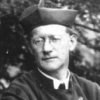
John Sebastian Marlow Ward (22 December 1885 – 1949) was an English author who published widely on the subject of Freemasonry and esotericism.
He was born in what is now Belize. In 1908 he graduated from the University of Cambridge with honours in history, following in the footsteps of his father, Herbert Ward who had also studied in history before entering the priesthood in the Anglican Church, as his father had done before him.
John Ward became a prolific and sometimes controversial writer on a wide variety of topics. He made contributions to the history of Freemasonry and other secret societies.
He was also a psychic medium or spiritualist, a prominent churchman and is still seen by some as a mystic and modern-day prophet.
Recent Articles: J.S.M Ward EAF Handbook

Book Review - The EA, FC, MM Handbooks
Essential reading for every Entered Apprentice, Fellowcraft, and Master Mason - these seminal books by J.S.M Ward are what every Mason needs!
more....
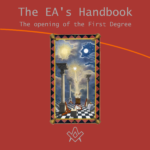 The Entered Apprentices Handbook P1 Chapter 1 - An interpretation of the first degree, the meaning of the preparation, symbolism, ritual and signs. Chapter 1, The opening of the First Degree |
 The Entered Apprentices Handbook P2 Chapter 2 - The Tyler or Outer Guard. The first thing that greets the eyes of the aspirant to our Order standing in front of the door with a drawn sword in his hand. |
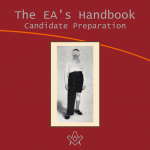 The Entered Apprentices Handbook P3 Chapter 3 - the Candidate being prepared by the Tyler. What we now have is a system by which the parts which have to be bare are made bare. |
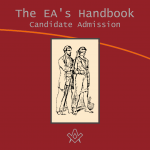 The Entered Apprentices Handbook P4 Chapter 4 - The candidate's admission into the lodge, is received on a sharp instrument. This signifies many things, one idea lying within the other. |
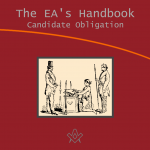 The Entered Apprentices Handbook P5 Chapter 5 - In all the ancient mysteries a candidate obligation was exacted to secure the secret teachings given in these mysteries which disclosed an inner meaning. |
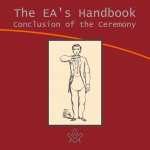 The Entered Apprentices Handbook P6 Chapter 6 - Having taken the first regular step the Candidate is given the Sign. This he is told refers to the Penalty of his Obligation, and no doubt it does, but it also seems to refer to something much more startling. |
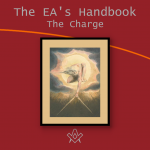 The Entered Apprentices Handbook P7 Chapter 7 - The candidate receives the charge, the first significant point is the phrase "Ancient, no doubt it is, as having subsisted from time immemorial". |
 In the second volume we are dealing with the degree of Life, in its broadest sense, just as in the first degree we were dealing with the degree of birth, and as life in reality is educational for the Soul, we are not surprised to find that throughout the whole degree the subject of education is more or less stressed. read the full series … |
 The third degree in Freemasonry is termed the Sublime Degree and the title is truly justified. Even in its exoteric aspect its simple, yet dramatic, power must leave a lasting impression on the mind of every Cand.. But its esoteric meaning contains some of the most profound spiritual instruction which it is possible to obtain to-day. read the full series … |
masonic knowledge
to be a better citizen of the world
share the square with two brothers

click image to open email app on mobile device







